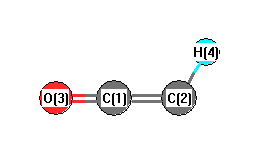Jump to
S1C2
Energy calculated at QCISD(T)/daug-cc-pVTZ
| | hartrees |
|---|
| Energy at 0K | -151.690174 |
| Energy at 298.15K | |
| HF Energy | -151.141218 |
| Nuclear repulsion energy | 52.270188 |
The energy at 298.15K was derived from the energy at 0K
and an integrated heat capacity that used the calculated vibrational frequencies.
Vibrational Frequencies calculated at QCISD(T)/daug-cc-pVTZ
| Mode Number |
Symmetry |
Frequency
(cm-1) |
Scaled Frequency
(cm-1) |
IR Intensities
(km mol-1) |
Raman Act
(Å4/u) |
Dep P |
Dep U |
|---|
| 1 |
Σ |
3445 |
3445 |
|
|
|
|
| 2 |
Σ |
2077 |
2077 |
|
|
|
|
| 3 |
Σ |
1275 |
1275 |
|
|
|
|
| 4 |
Π |
551 |
551 |
|
|
|
|
| 4 |
Π |
502 |
502 |
|
|
|
|
| 5 |
Π |
379 |
379 |
|
|
|
|
| 5 |
Π |
461i |
461i |
|
|
|
|
Unscaled Zero Point Vibrational Energy (zpe) 3884.9 cm
-1
Scaled (by 1) Zero Point Vibrational Energy (zpe) 3884.9 cm
-1
See section
III.C.1 List or set vibrational scaling factors
to change the scale factors used here.
See section
III.C.2
Calculate a vibrational scaling factor for a given set of molecules
to determine the least squares best scaling factor.
Geometric Data calculated at QCISD(T)/daug-cc-pVTZ
Point Group is C∞v
Cartesians (Å)
| Atom |
x (Å) |
y (Å) |
z (Å) |
|---|
| C1 |
0.000 |
0.000 |
0.019 |
| C2 |
0.000 |
0.000 |
-1.247 |
| O3 |
0.000 |
0.000 |
1.210 |
| H4 |
0.000 |
0.000 |
-2.310 |
Atom - Atom Distances (Å)
| |
C1 |
C2 |
O3 |
H4 |
| C1 | | 1.2668 | 1.1902 | 2.3299 |
C2 | 1.2668 | | 2.4570 | 1.0631 | O3 | 1.1902 | 2.4570 | | 3.5201 | H4 | 2.3299 | 1.0631 | 3.5201 | |
 More geometry information
More geometry information
Calculated Bond Angles
| atom1 |
atom2 |
atom3 |
angle |
|
atom1 |
atom2 |
atom3 |
angle |
| C1 |
C2 |
H4 |
180.000 |
|
C2 |
C1 |
O3 |
180.000 |
Electronic energy levels
Charges, Dipole, Quadrupole and Polarizability
Jump to
S1C1
Energy calculated at QCISD(T)/daug-cc-pVTZ
| | hartrees |
|---|
| Energy at 0K | -151.693925 |
| Energy at 298.15K | |
| HF Energy | -151.140407 |
| Nuclear repulsion energy | 52.082272 |
The energy at 298.15K was derived from the energy at 0K
and an integrated heat capacity that used the calculated vibrational frequencies.
Vibrational Frequencies calculated at QCISD(T)/daug-cc-pVTZ
| Mode Number |
Symmetry |
Frequency
(cm-1) |
Scaled Frequency
(cm-1) |
IR Intensities
(km mol-1) |
Raman Act
(Å4/u) |
Dep P |
Dep U |
|---|
| 1 |
A' |
3313 |
3313 |
|
|
|
|
| 2 |
A' |
2049 |
2049 |
|
|
|
|
| 3 |
A' |
1211 |
1211 |
|
|
|
|
| 4 |
A' |
574 |
574 |
|
|
|
|
| 5 |
A' |
514 |
514 |
|
|
|
|
| 6 |
A" |
491 |
491 |
|
|
|
|
Unscaled Zero Point Vibrational Energy (zpe) 4075.6 cm
-1
Scaled (by 1) Zero Point Vibrational Energy (zpe) 4075.6 cm
-1
See section
III.C.1 List or set vibrational scaling factors
to change the scale factors used here.
See section
III.C.2
Calculate a vibrational scaling factor for a given set of molecules
to determine the least squares best scaling factor.
Geometric Data calculated at QCISD(T)/daug-cc-pVTZ
Point Group is Cs
Cartesians (Å)
| Atom |
x (Å) |
y (Å) |
z (Å) |
|---|
| C1 |
0.000 |
0.061 |
0.000 |
| C2 |
1.123 |
-0.613 |
0.000 |
| O3 |
-1.110 |
0.450 |
0.000 |
| H4 |
2.148 |
-0.289 |
0.000 |
Atom - Atom Distances (Å)
| |
C1 |
C2 |
O3 |
H4 |
| C1 | | 1.3092 | 1.1769 | 2.1760 |
C2 | 1.3092 | | 2.4734 | 1.0751 | O3 | 1.1769 | 2.4734 | | 3.3411 | H4 | 2.1760 | 1.0751 | 3.3411 | |
 More geometry information
More geometry information
Calculated Bond Angles
| atom1 |
atom2 |
atom3 |
angle |
|
atom1 |
atom2 |
atom3 |
angle |
| C1 |
C2 |
H4 |
131.502 |
|
C2 |
C1 |
O3 |
168.384 |
Electronic energy levels
Charges, Dipole, Quadrupole and Polarizability
